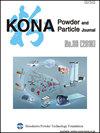Grain-size Effects on Mechanical Behavior and Failure of Dense Cohesive Granular Materials
IF 3.2
4区 材料科学
Q3 ENGINEERING, CHEMICAL
引用次数: 2
Abstract
The grain sizes can significantly influence the granular mechano-morphology, and consequently, the macro-scale mechanical response. From a purely geometric viewpoint, changing grain size will affect the volumetric number density of grain-pair interactions as well as the neighborhood geometry. In addition, changing grain size can influence initial stiffness and damage behavior of grain-pair interactions. The granular micromechanics approach (GMA), which provides a paradigm for bridging the grain-scale to continuum models, has the capability of describing the grain size influence in terms of both geometric effects and grain-pair deformation/dissipation effects. Here the GMA based Cauchy-type continuum model is enhanced using simple power laws to simulate the effect of grain size upon the volumetric number density of grain-pair interactions, and the parameters governing grain-pair deformation and dissipation mechanisms. The enhanced model is applied to predict the macroscopic response of cohesive granular solids under conventional triaxial tests. The results show that decreasing grain-sizes can trigger brittle-to-ductile transition in failure. Grain size is found to affect the compression/dilatation behavior as well as the post-peak softening/hardening of granular materials. The macro-scale failure/yield stress is also found to have an inverse relationship with grain-sizes in consonance with what has been reported in the literature.晶粒尺寸对致密粘性颗粒材料力学行为和破坏的影响
晶粒尺寸会显著影响颗粒的力学形态,从而影响宏观力学响应。从纯几何角度看,晶粒尺寸的变化会影响晶粒对相互作用的体积数密度以及邻近几何形状。此外,晶粒尺寸的改变会影响晶粒对相互作用的初始刚度和损伤行为。颗粒细观力学方法(GMA)提供了一种将晶粒尺度与连续介质模型连接起来的范式,能够从几何效应和晶粒对变形/耗散效应两方面描述晶粒尺寸的影响。本文利用简单幂律对基于GMA的cauchy型连续体模型进行了改进,模拟了晶粒尺寸对晶粒对相互作用体积数密度的影响,以及控制晶粒对变形和耗散机制的参数。应用该增强模型对常规三轴试验条件下粘性颗粒固体的宏观响应进行了预测。结果表明,减小晶粒尺寸可以触发脆性向韧性的转变。晶粒尺寸影响颗粒材料的压缩/膨胀行为以及峰后软化/硬化。宏观尺度的破坏/屈服应力也被发现与晶粒尺寸成反比关系,这与文献中报道的一致。
本文章由计算机程序翻译,如有差异,请以英文原文为准。
求助全文
约1分钟内获得全文
求助全文
来源期刊

KONA Powder and Particle Journal
工程技术-材料科学:综合
CiteScore
8.40
自引率
4.90%
发文量
35
审稿时长
>12 weeks
期刊介绍:
KONA publishes papers in the broad field of powder science and technology, ranging from fundamental principles to practical applications. Papers describing technological experience and critical reviews of existing knowledge in special areas are also welcome.
 求助内容:
求助内容: 应助结果提醒方式:
应助结果提醒方式:


